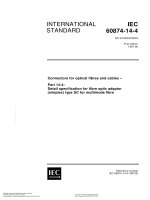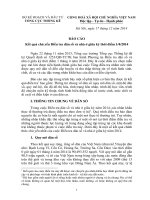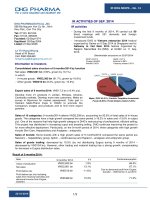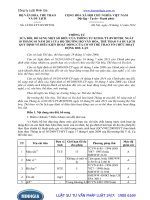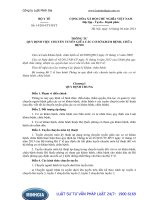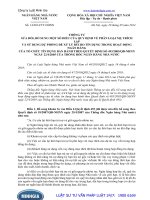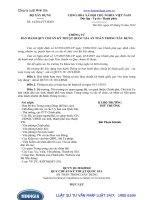Iec 60728 14 2014
Bạn đang xem bản rút gọn của tài liệu. Xem và tải ngay bản đầy đủ của tài liệu tại đây (1.24 MB, 116 trang )
®
Edition 1.0 2014-03
INTERNATIONAL
STANDARD
NORME
INTERNATIONALE
Cable networks for television signals, sound signals and interactive services –
Part 14: Optical transmission systems using RFoG technology
IEC 60728-14:2014-03(en-fr)
Réseaux de distribution par câbles pour signaux de télévision, signaux de
radiodiffusion sonore et services interactifs –
Partie 14: Systèmes de transmission optique appliquant la technologie RFoG
Copyrighted material licensed to BR Demo by Thomson Reuters (Scientific), Inc., subscriptions.techstreet.com, downloaded on Nov-27-2014 by James Madison. No further reproduction or distribution is permitted. Uncontrolled when printe
IEC 60728-14
Copyright © 2014 IEC, Geneva, Switzerland
All rights reserved. Unless otherwise specified, no part of this publication may be reproduced or utilized in any form
or by any means, electronic or mechanical, including photocopying and microfilm, without permission in writing from
either IEC or IEC's member National Committee in the country of the requester. If you have any questions about IEC
copyright or have an enquiry about obtaining additional rights to this publication, please contact the address below or
your local IEC member National Committee for further information.
Droits de reproduction réservés. Sauf indication contraire, aucune partie de cette publication ne peut être reproduite
ni utilisée sous quelque forme que ce soit et par aucun procédé, électronique ou mécanique, y compris la photocopie
et les microfilms, sans l'accord écrit de l'IEC ou du Comité national de l'IEC du pays du demandeur. Si vous avez des
questions sur le copyright de l'IEC ou si vous désirez obtenir des droits supplémentaires sur cette publication, utilisez
les coordonnées ci-après ou contactez le Comité national de l'IEC de votre pays de résidence.
IEC Central Office
3, rue de Varembé
CH-1211 Geneva 20
Switzerland
Tel.: +41 22 919 02 11
Fax: +41 22 919 03 00
www.iec.ch
About the IEC
The International Electrotechnical Commission (IEC) is the leading global organization that prepares and publishes
International Standards for all electrical, electronic and related technologies.
About IEC publications
The technical content of IEC publications is kept under constant review by the IEC. Please make sure that you have the
latest edition, a corrigenda or an amendment might have been published.
IEC Catalogue - webstore.iec.ch/catalogue
The stand-alone application for consulting the entire
bibliographical information on IEC International Standards,
Technical Specifications, Technical Reports and other
documents. Available for PC, Mac OS, Android Tablets and
iPad.
Electropedia - www.electropedia.org
The world's leading online dictionary of electronic and
electrical terms containing more than 30 000 terms and
definitions in English and French, with equivalent terms in 14
additional languages. Also known as the International
Electrotechnical Vocabulary (IEV) online.
IEC publications search - www.iec.ch/searchpub
The advanced search enables to find IEC publications by a
variety of criteria (reference number, text, technical
committee,…). It also gives information on projects, replaced
and withdrawn publications.
IEC Glossary - std.iec.ch/glossary
More than 55 000 electrotechnical terminology entries in
English and French extracted from the Terms and Definitions
clause of IEC publications issued since 2002. Some entries
have been collected from earlier publications of IEC TC 37,
77, 86 and CISPR.
IEC Just Published - webstore.iec.ch/justpublished
Stay up to date on all new IEC publications. Just Published
details all new publications released. Available online and
also once a month by email.
IEC Customer Service Centre - webstore.iec.ch/csc
If you wish to give us your feedback on this publication or
need further assistance, please contact the Customer Service
Centre:
A propos de l'IEC
La Commission Electrotechnique Internationale (IEC) est la première organisation mondiale qui élabore et publie des
Normes internationales pour tout ce qui a trait à l'électricité, à l'électronique et aux technologies apparentées.
A propos des publications IEC
Le contenu technique des publications IEC est constamment revu. Veuillez vous assurer que vous possédez l’édition la
plus récente, un corrigendum ou amendement peut avoir été publié.
Catalogue IEC - webstore.iec.ch/catalogue
Application autonome pour consulter tous les renseignements
bibliographiques
sur
les
Normes
internationales,
Spécifications techniques, Rapports techniques et autres
documents de l'IEC. Disponible pour PC, Mac OS, tablettes
Android et iPad.
Recherche de publications IEC - www.iec.ch/searchpub
La recherche avancée permet de trouver des publications IEC
en utilisant différents critères (numéro de référence, texte,
comité d’études,…). Elle donne aussi des informations sur les
projets et les publications remplacées ou retirées.
IEC Just Published - webstore.iec.ch/justpublished
Restez informé sur les nouvelles publications IEC. Just
Published détaille les nouvelles publications parues.
Disponible en ligne et aussi une fois par mois par email.
Electropedia - www.electropedia.org
Le premier dictionnaire en ligne de termes électroniques et
électriques. Il contient plus de 30 000 termes et dộfinitions en
anglais et en franỗais, ainsi que les termes équivalents dans
14 langues additionnelles. Egalement appelé Vocabulaire
Electrotechnique International (IEV) en ligne.
Glossaire IEC - std.iec.ch/glossary
Plus de 55 000 entrées terminologiques électrotechniques, en
anglais et en franỗais, extraites des articles Termes et
Dộfinitions des publications IEC parues depuis 2002. Plus
certaines entrées antérieures extraites des publications des
CE 37, 77, 86 et CISPR de l'IEC.
Service Clients - webstore.iec.ch/csc
Si vous désirez nous donner des commentaires sur cette
publication ou si vous avez des questions contactez-nous:
Copyrighted material licensed to BR Demo by Thomson Reuters (Scientific), Inc., subscriptions.techstreet.com, downloaded on Nov-27-2014 by James Madison. No further reproduction or distribution is permitted. Uncontrolled when printe
THIS PUBLICATION IS COPYRIGHT PROTECTED
®
Edition 1.0 2014-03
INTERNATIONAL
STANDARD
NORME
INTERNATIONALE
Cable networks for television signals, sound signals and interactive services –
Part 14: Optical transmission systems using RFoG technology
Réseaux de distribution par câbles pour signaux de télévision, signaux de
radiodiffusion sonore et services interactifs –
Partie 14: Systèmes de transmission optique appliquant la technologie RFoG
INTERNATIONAL
ELECTROTECHNICAL
COMMISSION
COMMISSION
ELECTROTECHNIQUE
INTERNATIONALE
PRICE CODE
CODE PRIX
ICS 33.060.40; 33.160; 33.180
XA
ISBN 978-2-8322-1439-8
Warning! Make sure that you obtained this publication from an authorized distributor.
Attention! Veuillez vous assurer que vous avez obtenu cette publication via un distributeur agréé.
® Registered trademark of the International Electrotechnical Commission
Marque déposée de la Commission Electrotechnique Internationale
Copyrighted material licensed to BR Demo by Thomson Reuters (Scientific), Inc., subscriptions.techstreet.com, downloaded on Nov-27-2014 by James Madison. No further reproduction or distribution is permitted. Uncontrolled when printe
IEC 60728-14
IEC 60728-14:2014 © IEC 2014
CONTENTS
FOREWORD ........................................................................................................................... 5
INTRODUCTION ..................................................................................................................... 7
1
Scope .............................................................................................................................. 8
2
Normative references ....................................................................................................... 8
3
Terms, definitions, symbols and abbreviations ................................................................ 10
4
3.1
3.2
3.3
System
5
RFoG ONU reference architecture ................................................................................. 18
6
Method of measurements ............................................................................................... 19
Terms and definitions ....................................................................................... 10
Symbols ........................................................................................................... 16
Abbreviations ................................................................................................... 16
reference model ................................................................................................ 17
6.1
6.2
6.3
6.4
6.5
6.6
6.7
6.8
7
Optical power ................................................................................................... 19
Centroidal wavelength and spectral width under modulation .............................. 19
Optical wavelength ........................................................................................... 20
Linewidth and chirping of transmitters with single mode lasers .......................... 20
Optical modulation index .................................................................................. 20
Reference output level of an optical receiver..................................................... 20
Noise parameters of optical transmitters and optical receivers .......................... 20
Relative intensity noise (RIN), optical modulation index and equivalent
input noise current (EINC) ................................................................................ 20
6.9
Carrier level and carrier-to-noise ratio .............................................................. 20
6.10
Noise power ratio (NPR) ................................................................................... 20
6.11
Carrier-to-noise ratio defined by optical signal .................................................. 21
6.12
Carrier-to-crosstalk ratio (CCR) ........................................................................ 21
System performance requirements ................................................................................. 21
7.1
8
Digital data system ........................................................................................... 21
7.1.1
ODN ............................................................................................... 21
7.1.2
Performance allocation ................................................................... 21
7.2
Forward path and return path frequency split .................................................... 22
RFoG equipment specifications ...................................................................................... 22
8.1
8.2
8.3
General specifications ...................................................................................... 22
8.1.1
Safety ............................................................................................. 22
8.1.2
Electromagnetic compatibility (EMC) ............................................... 22
8.1.3
Environmental conditions ................................................................ 22
8.1.4
Marking .......................................................................................... 23
R-ONU ............................................................................................................. 23
8.2.1
Indicators ........................................................................................ 23
8.2.2
R-ONU forward path receiver specifications .................................... 23
8.2.3
Return path performance of R-ONU ................................................ 25
8.2.4
Remote control functions ................................................................ 29
Headend specifications .................................................................................... 34
8.3.1
Headend forward path specifications ............................................... 34
8.3.2
Headend return path specifications: R-RRX ..................................... 34
Copyrighted material licensed to BR Demo by Thomson Reuters (Scientific), Inc., subscriptions.techstreet.com, downloaded on Nov-27-2014 by James Madison. No further reproduction or distribution is permitted. Uncontrolled when printe
–2–
–3–
Annex A (informative) Implementation notes ......................................................................... 36
Annex B (informative) System loss specification ................................................................... 38
B.1
General ............................................................................................................ 38
B.2
Forward path considerations ............................................................................. 38
B.3
Return path considerations ............................................................................... 39
Annex C (informative) Optical beat interference .................................................................... 42
C.1
C.2
C.3
C.4
C.5
C.6
C.7
C.8
C.9
General ............................................................................................................ 42
Operating conditions of ODN ............................................................................ 42
Operating conditions of optical receiver at the headend system......................... 42
Operating conditions of CMTS .......................................................................... 43
Environmental conditions.................................................................................. 43
Relation between optical transmission loss and OMI ......................................... 43
Design margin of ODN ..................................................................................... 44
Example of system design ................................................................................ 45
Method of measurement of OBI ........................................................................ 46
C.9.1
Purpose .......................................................................................... 46
C.9.2
Measurement setup ........................................................................ 46
C.9.3
Example of measurement conditions ............................................... 46
C.9.4
Procedure ....................................................................................... 47
C.9.5
Presentation of results .................................................................... 47
C.10
Method of measurement of OBI (measurement with CW signals) ...................... 47
C.10.1
Purpose .......................................................................................... 47
C.10.2
Measurement setup ........................................................................ 47
C.10.3
Procedure ....................................................................................... 48
Annex D (normative) Optional remote control manager ......................................................... 49
Annex E (informative) Outdoor housings for R-ONU protection ............................................. 50
Annex F (informative) Effect of off-state optical power on C/N ratio of transmission
signal............................................................................................................................. 51
Bibliography .......................................................................................................................... 53
Figure 1 – Optical system reference model for RFoG ............................................................. 18
Figure 2 – Principle schematics of R-ONU ............................................................................. 19
Figure 3 – Measurement of optical wavelength using WDM coupler ....................................... 20
Figure 4 – R-ONU turn-on and turn-off diagram ..................................................................... 29
Figure 5 – Example of the remote control system configuration .............................................. 30
Figure 6 – Data format .......................................................................................................... 31
Figure 7 – Structure of data packet ........................................................................................ 31
Figure 8 – Control transfer process ....................................................................................... 32
Figure 9 – Timing of data transmission .................................................................................. 32
Figure A.1 – Placement of attenuators when system loss is too low ....................................... 37
Figure B.1 – Performance allocation of the return path transmission system .......................... 39
Figure B.2 – Section C/N specification for SDU and MDU in-house wiring............................... 41
Figure C.1 – Optical transmission loss and OMI ..................................................................... 44
Figure C.2 – ODN design margin ........................................................................................... 44
Figure C.3 – Setup used for the measurement of OBI ............................................................ 46
Copyrighted material licensed to BR Demo by Thomson Reuters (Scientific), Inc., subscriptions.techstreet.com, downloaded on Nov-27-2014 by James Madison. No further reproduction or distribution is permitted. Uncontrolled when printe
IEC 60728-14:2014 © IEC 2014
IEC 60728-14:2014 © IEC 2014
Figure C.4 – Setup used for the measurement of OBI (CW method)....................................... 48
Table 1 – ODN Specifications ................................................................................................ 21
Table 2 – RF frequencies ...................................................................................................... 22
Table 3 – Classification of R-ONU optical receivers ............................................................... 24
Table 4 – Data publication requirements for R-ONU optical receivers..................................... 24
Table 5 – Recommendations for R-ONU optical receivers ...................................................... 24
Table 6 – Performance requirements for R-ONU optical receivers.......................................... 25
Table 7 – Classes of optical return path transmitters ............................................................. 25
Table 8 – Data publication requirements for optical return path transmitters ........................... 26
Table 9 – Performance requirements for optical parameters and interfaces............................ 26
Table 10 – Electrical properties requirements for R-ONU optical return path transmitters ....... 27
Table 11 – R-ONU turn-on and turn-off specifications ............................................................ 27
Table 12 – Remote control items ........................................................................................... 30
Table 13 – Fundamental specification of data communication ................................................ 31
Table 14 – Content of data packets ....................................................................................... 31
Table 15 – R-ONU address ................................................................................................... 32
Table 16 – Recommendation for timing of data transmission.................................................. 33
Table 17 – Remote control command codes .......................................................................... 33
Table 18 – Specification of modulation for the remote control signal ...................................... 34
Table 19 – Data publication requirements for return path optical receivers ............................. 35
Table 20 – Performance requirements for optical return path receivers .................................. 35
Table C.1 – Operating conditions related to ODN parameters ................................................ 42
Table C.2 – Operating conditions related to ODN parameters ................................................ 43
Table C.3 – Environmental conditions for system evaluation .................................................. 43
Table C.4 – Factors affecting the transmission loss of ODN ................................................... 45
Table C.5 – System design example 1 ................................................................................... 45
Table C.6 – System design example 2 ................................................................................... 45
Table C.7 – Example of list of measurement conditions ......................................................... 46
Table C.8 – Presentation of OBI measurement results ........................................................... 47
Table C.9 – Presentation of OBI measurement results ........................................................... 48
Table D.1 – Performance requirements for the FSK transmitter ............................................. 49
Copyrighted material licensed to BR Demo by Thomson Reuters (Scientific), Inc., subscriptions.techstreet.com, downloaded on Nov-27-2014 by James Madison. No further reproduction or distribution is permitted. Uncontrolled when printe
–4–
–5–
INTERNATIONAL ELECTROTECHNICAL COMMISSION
____________
CABLE NETWORKS FOR TELEVISION SIGNALS,
SOUND SIGNALS AND INTERACTIVE SERVICES –
Part 14: Optical transmission systems using RFoG technology
FOREWORD
1) The International Electrotechnical Commission (IEC) is a worldwide organization for standardization comprising
all national electrotechnical committees (IEC National Committees). The object of IEC is to promote
international co-operation on all questions concerning standardization in the electrical and electronic fields. To
this end and in addition to other activities, IEC publishes International Standards, Technical Specifications,
Technical Reports, Publicly Available Specifications (PAS) and Guides (hereafter referred to as “IEC
Publication(s)”). Their preparation is entrusted to technical committees; any IEC National Committee interested
in the subject dealt with may participate in this preparatory work. International, governmental and nongovernmental organizations liaising with the IEC also participate in this preparation. IEC collaborates closely
with the International Organization for Standardization (ISO) in accordance with conditions determined by
agreement between the two organizations.
2) The formal decisions or agreements of IEC on technical matters express, as nearly as possible, an international
consensus of opinion on the relevant subjects since each technical committee has representation from all
interested IEC National Committees.
3) IEC Publications have the form of recommendations for international use and are accepted by IEC National
Committees in that sense. While all reasonable efforts are made to ensure that the technical content of IEC
Publications is accurate, IEC cannot be held responsible for the way in which they are used or for any
misinterpretation by any end user.
4) In order to promote international uniformity, IEC National Committees undertake to apply IEC Publications
transparently to the maximum extent possible in their national and regional publications. Any divergence
between any IEC Publication and the corresponding national or regional publication shall be clearly indicated in
the latter.
5) IEC itself does not provide any attestation of conformity. Independent certification bodies provide conformity
assessment services and, in some areas, access to IEC marks of conformity. IEC is not responsible for any
services carried out by independent certification bodies.
6) All users should ensure that they have the latest edition of this publication.
7) No liability shall attach to IEC or its directors, employees, servants or agents including individual experts and
members of its technical committees and IEC National Committees for any personal injury, property damage or
other damage of any nature whatsoever, whether direct or indirect, or for costs (including legal fees) and
expenses arising out of the publication, use of, or reliance upon, this IEC Publication or any other IEC
Publications.
8) Attention is drawn to the Normative references cited in this publication. Use of the referenced publications is
indispensable for the correct application of this publication.
9) Attention is drawn to the possibility that some of the elements of this IEC Publication may be the subject of
patent rights. IEC shall not be held responsible for identifying any or all such patent rights.
International Standard IEC 60728-14 has been prepared by technical area 5: Cable networks
for television signals, sound signals and interactive services, of IEC technical committee 100:
Audio, video and multimedia systems and equipment.
The text of this standard is based on the following documents:
FDIS
Report on voting
100/2248/FDIS
100/2284/RVD
Full information on the voting for the approval of this standard can be found in the report on
voting indicated in the above table.
Copyrighted material licensed to BR Demo by Thomson Reuters (Scientific), Inc., subscriptions.techstreet.com, downloaded on Nov-27-2014 by James Madison. No further reproduction or distribution is permitted. Uncontrolled when printe
IEC 60728-14:2014 © IEC 2014
IEC 60728-14:2014 © IEC 2014
This publication has been drafted in accordance with the ISO/IEC Directives, Part 2.
The list of all the parts of the IEC 60728 series, under the general title Cable networks for
television signals, sound signals and interactive services, can be found on the IEC website.
This standard follows closely (where applicable) the ANSI/SCTE 174 2010 standard “Radio
Frequency over Glass / Fiber-to-the-Home Specification”. In agreement with SCTE 1 major
parts of ANSI/SCTE 174:2010 have been copied into this standard.
The committee has decided that the contents of this publication will remain unchanged until
the stability date indicated on the IEC web site under "" in the data
related to the specific publication. At this date, the publication will be
reconfirmed,
withdrawn,
replaced by a revised edition, or
amended.
___________
1 SCTE = Society of Cable Telecommunications Engineers
Copyrighted material licensed to BR Demo by Thomson Reuters (Scientific), Inc., subscriptions.techstreet.com, downloaded on Nov-27-2014 by James Madison. No further reproduction or distribution is permitted. Uncontrolled when printe
–6–
–7–
INTRODUCTION
Standards and other deliverables of the IEC 60728 series deal with cable networks including
equipment and associated methods of measurement for headend reception, processing and
distribution of television and sound signals and for processing, interfacing and transmitting all
kinds of data signals for interactive services using all applicable transmission media. These
signals are typically transmitted in networks by frequency-multiplexing techniques.
•
regional and local broadband cable networks,
•
extended satellite and terrestrial television distribution systems,
•
individual satellite and terrestrial television receiving systems,
and all kinds of equipment, systems and installations used in such cable networks, distribution
and receiving systems.
The extent of this standardization work is from the antennas and/or special signal source inputs
to the headend or other interface points to the network up to the terminal input of the customer
premises equipment.
The standardization work will consider coexistence with users of the RF spectrum in wired and
wireless transmission systems.
The standardization of any user terminals (i.e., tuners, receivers, decoders, multimedia
terminals, etc.) as well as of any coaxial, balanced and optical cables and accessories thereof
is excluded.
The Annexes provide the following information.
Annex A
describes implementation notes with design consideration based on this standard
Annex B
describes the system loss specification
Annex C
describes multiple CMTS operation
Annex D
contains specifications for an optional remote control system
Annex E
gives a design guideline of housings for R-ONU protection
Annex F
contains information on the effect of off-state optical power on C/N ratio of
transmission signal
Copyrighted material licensed to BR Demo by Thomson Reuters (Scientific), Inc., subscriptions.techstreet.com, downloaded on Nov-27-2014 by James Madison. No further reproduction or distribution is permitted. Uncontrolled when printe
IEC 60728-14:2014 © IEC 2014
IEC 60728-14:2014 © IEC 2014
CABLE NETWORKS FOR TELEVISION SIGNALS,
SOUND SIGNALS AND INTERACTIVE SERVICES –
Part 14: Optical transmission systems using RFoG technology
1
Scope
This part of IEC 60728 describes the system and equipment specification of FTTH/FTTB (fibre
to the home/fibre to the building) networks where information is transmitted in both, forward
and return path directions using RF subcarrier multiplexing technology, and where the return
path transmission uses additionally time division multiple access technique imposed by the
transmission of the return path signals using a TDMA (e.g. TDMA mode of DOCSIS) protocol.
Such systems are called RF over Glass (RFoG) and consist of an RFoG optical network unit
(R-ONU), an optical distribution network based on xPON structure, and an RFoG optical return
path receiver. This standard specifies the basic system parameters and methods of
measurement for RFoG systems in order to assess the system performance and its
performance limits.
The detailed description of physical layer is out of the scope of this standard and it does not
include IP transport technologies.
2
Normative references
The following documents, in whole or in part, are normatively referenced in this document and
are indispensable for its application. For dated references, only the edition cited applies. For
undated references, the latest edition of the referenced document (including any amendments)
applies.
IEC 60068-1:1988, Environmental testing – Part 1: General and guidance
IEC 60068-2-1, Environmental testing – Part 2-1: Tests – Test A: Cold
IEC 60068-2-2, Environmental testing – Part 2-2: Tests – Test B: Dry heat
IEC 60068-2-6:2007, Environmental testing – Part 2-6: Tests – Test Fc: Vibration (sinusoidal)
IEC 60068-2-14, Environmental testing – Part 2-14: Tests – Test N: Change of temperature
IEC 60068-2-27, Environmental testing – Part 2-27: Tests – Test Ea and guidance: Shock
IEC 60068-2-30, Environmental testing – Part 2-30: Tests – Test Db: Damp heat, cyclic (12 h +
12 h cycle)
IEC 60068-2-31, Environmental testing – Part 2-31: Tests – Test Ec: Rough handling shocks,
primarily for equipment-type specimens
IEC 60068-2-40, Environmental testing – Part 2-40: Tests – Test Z/AM: Combined cold/low air
pressure tests
IEC 60529, Degrees of protection provided by enclosures (IP Code)
Copyrighted material licensed to BR Demo by Thomson Reuters (Scientific), Inc., subscriptions.techstreet.com, downloaded on Nov-27-2014 by James Madison. No further reproduction or distribution is permitted. Uncontrolled when printe
–8–
–9–
IEC 60728-1, Cable networks for television signals, sound signals and interactive services –
Part 1: System performance of forward paths
IEC 60728-2, Cable networks for television signals, sound signals and interactive services –
Part 2: Electromagnetic compatibility of equipment
IEC 60728-3, Cable networks for television signals, sound signals and interactive services –
Part 3: Active wideband equipment for cable networks
IEC 60728-6:2011, Cable networks for television signals, sound signals and interactive
services – Part 6: Optical equipment
IEC 60728-10:2014, Cable networks for television signals, sound signals and interactive
services – Part 10: System performance of return path
IEC 60728-11, Cable networks for television signals, sound signals and interactive services –
Part 11: Safety
IEC 60728-13:2010, Cable networks for television signals, sound signals and interactive
services – Part 13: Optical systems for broadcast signal transmissions
IEC 60728-13-1:2012, Cable networks for television signals, sound signals and interactive
services – Part 13-1: Bandwidth expansion for broadcast signal over FTTH system
IEC 60793-2-50:2012, Optical fibres – Part
specification for class B single-mode fibres
2-50: Product specifications
– Sectional
IEC 60794-3-11:2010, Optical fibre cables – Part 3-11: Outdoor cables – Product specification
for duct, directly buried, and lashed aerial single-mode optical fibre telecommunication cables
IEC 60825-1, Safety of laser products – Part 1: Equipment classification and requirements
IEC 61169-2, Radio-frequency connectors – Part 2: Sectional specification – Radio frequency
coaxial connectors type 9,52
IEC 61169-24, Radio-frequency connectors – Part 24: Sectional specification – Radiofrequency coaxial connectors with screw coupling, typically for use in 75 ohm cable distribution
systems (Type F)
IEC 61280-1-1, Fibre optic communication subsystem basic test procedures – Part 1-1:Test
procedures for general communication subsystems – Transmitter output optical power
measurement for single-mode optical fibre cable
IEC 61280-1-3, Fibre optic communication subsystem test procedures – Part 1-3: General
communication subsystems – Central wavelength and spectral width measurement
IEC 61754-4, Fibre optic interconnecting devices and passive components – Fibre optic
connector interfaces – Part 4: Type SC connector family
IEC/TR 61931:1998, Fibre optics – Terminology
IEEE Standard 802.3-2008, Carrier sense multiple access with Collision Detection (CSMA/CD)
Access Method and Physical Layer Specifications (Includes the EPON standard). See also
subsequent corrigenda
Copyrighted material licensed to BR Demo by Thomson Reuters (Scientific), Inc., subscriptions.techstreet.com, downloaded on Nov-27-2014 by James Madison. No further reproduction or distribution is permitted. Uncontrolled when printe
IEC 60728-14:2014 © IEC 2014
IEC 60728-14:2014 © IEC 2014
IEEE Standard 802.3av-2009, IEEE Standard for Information Technology-Part 3: Amendment 1:
Physical Layer Specifications and Management Parameters for 10Gb/s Passive Optical
Networks, October 2009
3
Terms, definitions, symbols and abbreviations
3.1
Terms and definitions
For the purposes of this document, the terms and definitions given in IEC 60728-1 and
IEC/TR 61931 as well as the following apply.
3.1.1
carrier-to-crosstalk ratio
CCR
level difference of desired signal carrier level and worst case of other services single frequency
crosstalk signal measured at RF output port of optical receiver
Note 1 to entry:
CCR is defined by the following equation:
CCR = D − U OtherService
(1)
where
D
is the nominal level of the desired signal in dB(µV) at RF output port of optical receiver;
U OtherService
is the worst case level of another service’s single frequency crosstalk in dB(µV) at RF output port
of the optical receiver.
Note 2 to entry:
CCR is expressed in dB.
3.1.2
equivalent input noise current density
notional input noise current density which, when applied to the input of an ideal noiseless
device, produces an output noise current density equal in value to that observed at the output
of the actual device under consideration
Note 1 to entry:
using:
It can be calculated from the carrier-to-noise ratio C/N (see IEC 60728-6) of a device or system
Ir =
C
1
Z 10 10 C/N
(2)
where
C
is the power of the carrier at the input of the device or system, in W/Hz;
Z
is its input impedance, in Ω.
Note 2 to entry:
The equivalent input noise current density is expressed in A/√Hz.
3.1.3
extended satellite television distribution network or system
distribution network or system designed to provide sound and television signals received by
satellite receiving antenna to households in one or more buildings
Note 1 to entry: This kind of network or system can be combined with terrestrial antennas for the additional
reception of TV and/or radio signals via terrestrial networks.
Note 2 to entry: This kind of network or system can also carry control signals for satellite switched systems or
other signals for special transmission systems (e.g. MoCA or WiFi) in the return path direction.
Copyrighted material licensed to BR Demo by Thomson Reuters (Scientific), Inc., subscriptions.techstreet.com, downloaded on Nov-27-2014 by James Madison. No further reproduction or distribution is permitted. Uncontrolled when printe
– 10 –
– 11 –
3.1.4
extended terrestrial television distribution network or system
distribution network or system designed to provide sound and television signals received by
terrestrial receiving antenna to households in one or more buildings
Note 1 to entry: This kind of network or system can be combined with a satellite antenna for the additional
reception of TV and/or radio signals via satellite networks.
Note 2 to entry: This kind of network or system can also carry other signals for special transmission systems (e.g.
MoCA or WiFi) in the return path direction.
3.1.5
fibre optic branching device
<optical> <fibre> branching device
<optical> splitter
DEPRECATED: <optical> <fibre> coupler
device, possessing three or more optical ports, which shares optical power among its ports in a
predetermined fashion, at the same wavelength or wavelengths, without wavelength conversion
Note 1 to entry:
The ports may be connected to fibres, sources, detectors, etc.
[SOURCE: IEC/TR 61931:1998, definition 2.6.21]
3.1.6
flatness
difference between the maximum and the minimum RF gain or attenuation not taking into
account the slope within the specified modulation frequency range of a device or system
3.1.7
headend system
system comprising modulators, demodulators, CMTS, an optical transmitter with optional
optical amplifiers and a WDM for the transmission of analogue video as well as digitally
modulated signals located at the central office side of the optical network
Note 1 to entry: The headend system is equipped with an optical return path receiver receiving digitally modulated
signals of data in the return path direction to enable e.g. VoIP, VOD and internet services.
Note 2 to entry:
V-OLT is a part of the headend system and deals with video transmission in the forward path only.
3.1.8
individual satellite television receiving system
system designed to provide sound and television signals received from satellite(s) to an
individual household
Note 1 to entry: This kind of system can also carry control signals for satellite switched systems or other signals
for special transmission systems (e.g. MoCA or WiFi) in the return path direction.
3.1.9
individual terrestrial television receiving system
system designed to provide sound and television signals received via terrestrial broadcast
networks to an individual household
Note 1 to entry: This kind of system can also carry other signals for special transmission systems (e.g. MoCA or
WiFi) in the return path direction.
3.1.10
local broadband cable network
network designed to provide sound and television signals as well as signals for interactive
services to a local area (e.g. one town or one village)
Copyrighted material licensed to BR Demo by Thomson Reuters (Scientific), Inc., subscriptions.techstreet.com, downloaded on Nov-27-2014 by James Madison. No further reproduction or distribution is permitted. Uncontrolled when printe
IEC 60728-14:2014 © IEC 2014
IEC 60728-14:2014 © IEC 2014
3.1.11
multiplexing device
WDM device
wavelength selective branching device (used in WDM transmission systems) in which optical
signals can be transferred between two predetermined ports, depending on the wavelength of
the signal
[SOURCE: IEC/TR 61931:1998, definition 2.6.51]
3.1.12
noise power ratio
NPR
ratio of the signal power density to the power density of the combined noise and
intermodulation distortion
3.1.13
off-state optical power
residual optical output power emitted from the fibre of the R-ONU when the laser is switched to
off-state
Note 1 to entry: In a typical burst mode transmitter, for fast switching operation, the laser bias may be kept near
the threshold bias level to avoid turn-on and turn-off delays. The off-state optical power affects the system
performance when a large number of transmitters are connected to the same distribution network.
3.1.14
optical amplifier
OA
optical waveguide device containing a suitably pumped, active medium which is able to amplify
an optical signal
[SOURCE: IEC/TR 61931:1998, definition 2.7.75]
3.1.15
optical distribution network
ODN
passive optical network (PON) mainly consisting of optical fibres and splitters
3.1.16
optical receiving unit
optical receiver
Rx
receive fibre optic terminal device accepting at its input port a modulated optical carrier, and
providing at its output port the corresponding demodulated electrical signal (with the associated
clock, if digital)
[SOURCE: IEC/TR 61931:1998, definition 2.9.7]
Note 1 to entry: For the purposes of this standard, optical receivers may have more than one output port providing
electrical RF signals.
3.1.17
optical modulation index
index defined as
Copyrighted material licensed to BR Demo by Thomson Reuters (Scientific), Inc., subscriptions.techstreet.com, downloaded on Nov-27-2014 by James Madison. No further reproduction or distribution is permitted. Uncontrolled when printe
– 12 –
– 13 –
m=
φh - φl
φh +φl
(3)
where φ h is the highest and φ l is the lowest instantaneous optical power of the intensity
modulated optical signal
Note 1 to entry: This definition does not apply to systems where the input signals are converted and transported
as digital baseband signals. In this case, the terms modulation depth or extinction ratio defined in 2.6.79 and 2.7.46
of IEC/TR 61931:1998 are used. A test procedure for extinction ratio is described in IEC 61280-2-2.
[SOURCE: IEC 60728-6:2011, definition 3.1.10, modified – repetition of "optical modulation"
has been deleted.]
3.1.18
optical return loss
return loss
ORL
ratio of the total reflected power to the incident power from an optical fibre, optical device, or
optical system, and defined as:
− 10 lg
Pr
Pi
(4)
where
Pr
is the reflected power;
Pi
is the incident power
Note 1 to entry:
term.
When referring to a reflected power from an individual component, reflectance is the preferred
[SOURCE: IEC/TR 61931:1998, definition 2.6.49]
Note 2 to entry: For the purposes of this standard, the term reflectance is used for optical amplifiers only. The
term optical return loss is used for ports of all other types of equipment.
Note 3 to entry:
this case.
The term return loss is also used for electrical ports. The definition relates to electrical powers in
Note 4 to entry:
The ratio is expressed in dB.
3.1.19
optical transmitting unit
optical transmitter
Tx
transmit fibre optic terminal device accepting at its input port an electrical signal and providing
at its output port an optical carrier modulated by that input signal
[SOURCE: IEC/TR 61931:1998, definition 2.9.6]
Note 1 to entry: For the purposes of this standard, optical transmitters may have more than one input port
accepting electrical RF signals.
Copyrighted material licensed to BR Demo by Thomson Reuters (Scientific), Inc., subscriptions.techstreet.com, downloaded on Nov-27-2014 by James Madison. No further reproduction or distribution is permitted. Uncontrolled when printe
IEC 60728-14:2014 © IEC 2014
IEC 60728-14:2014 © IEC 2014
3.1.20
radio frequency over glass
RFoG
transmission technology on optical networks where information is transmitted in both, forward
and return path directions, using RF subcarrier multiplexing technology, and where the return
path transmission uses additionally time division multiple access technique imposed by the
transmission of the return path signals using a TDMA (e.g. TDMA mode of DOCSIS) protocol
3.1.21
reference output level of an optical receiver
offset x by which the electrical output level of an optical receiver can be calculated from the
optical input level at a modulation index of m = 0,05 using the following equation:
U = 2 P opt,RX + x dB(µV)
(5)
where
U
is the electrical output level in dB(µV)
P opt,RX
is the optical input level in dB(mW)
x
is the reference output level in dB(µV)
3.1.22
responsivity
ratio of an optical detector’s electrical output to its optical input at a given wavelength
Note 1 to entry:
power.
The responsivity is expressed in ampere per watt (A/W) or volts per watt (V/W) of incident radiant
Note 2 to entry:
Sensitivity is sometimes used as an imprecise synonym for responsivity.
[SOURCE: IEC 60050-731:1991, 731-06-36, modified – "given wavelength" has been added
and Note 1 has been clarified.]
Note 3 to entry:
The wavelength interval around the given wavelength may be specified.
[SOURCE: IEC/TR 61931:1998, definition 2.7.56]
3.1.23
relative intensity noise
RIN
ratio of the mean square of the intensity fluctuations in the optical power of a light source to the
square of the mean of the optical output power
Note 1 to entry:
The RIN is usually expressed in dB(Hz −1 ) resulting in negative values.
Note 2 to entry:
system.
The value for the RIN can be calculated from the results of a carrier-to-noise measurement for the
[SOURCE: IEC 60728-6:2011, 3.1.12]
3.1.24
RFoG optical network unit
R-ONU
fibre optic terminal comprising an optical receiver for reception of analogue signals and an
optical transmitter for the transmission of analogue signals originating from the customer side
of the optical network and a coaxial interface for the transmission of analogue signals to the
customer network and reception of analogue signals from the customer network generally
consisting of digital data using a TDMA (e.g. TDMA mode of DOCSIS) protocol
Copyrighted material licensed to BR Demo by Thomson Reuters (Scientific), Inc., subscriptions.techstreet.com, downloaded on Nov-27-2014 by James Madison. No further reproduction or distribution is permitted. Uncontrolled when printe
– 14 –
– 15 –
3.1.25
slope
gain or attenuation difference at two defined frequencies between two ports of a device or
system
Note 1 to entry:
In this standard the term slope relates only to the electrical gain or attenuation of equipment.
Note 2 to entry: In equipment for cable networks a line of best fit of the amplitude frequency response is
considered at the band limits (see IEC 60728-6).
[SOURCE: IEC 60728-6:2011, 3.1.29]
3.1.26
<stimulated> Brillouin scattering
SBS
non-linear scattering of optical radiation characterized by a frequency shift as for the Raman
scattering, but accompanied by a lower frequency (acoustical) vibration of the medium lattice;
the light is scattered backward with respect to the incident radiation
Note 1 to entry:
In silica fibres the frequency shift is typically around 10 GHz.
[SOURCE: IEC/TR 61931:1998, definition 2.1.88]
3.1.27
video optical network unit
V-ONU
terminal unit that changes the forward path optical signal into an electrical signal
Note 1 to entry:
This functionality of this device is a part of an R-ONU.
3.1.28
wavelength
distance covered in a period by the wavefront of a harmonic plane wave
[SOURCE: IEC/TR 61931:1998, definition 2.2.9]
Note 1 to entry:
The wavelength λ of light in vacuum is given by
λ=
c
f
(6)
where
c
is the speed of light in vacuum (c ≈ 2,997 92 × 10 8 m/s);
f
is the optical frequency.
Note 2 to entry: Although the wavelength in dielectric material such as fibres is shorter than in vacuum, only the
wavelength of light in vacuum is used.
Copyrighted material licensed to BR Demo by Thomson Reuters (Scientific), Inc., subscriptions.techstreet.com, downloaded on Nov-27-2014 by James Madison. No further reproduction or distribution is permitted. Uncontrolled when printe
IEC 60728-14:2014 © IEC 2014
3.2
IEC 60728-14:2014 © IEC 2014
Symbols
The following graphical symbols are used in the figures of this standard. These symbols are
either listed in IEC 60617 or based on symbols defined in IEC 60617.
E
O
Optical transmitter
based on
[IEC 60617-S00213
(2001-07)]
TV
A
E
Optical receiver
based on
[IEC 60617-S00213
(2001-07)]
Optical amplifier
based on
[IEC 60617-S00127
(2001-07) and
IEC 60617-S01239
(2001-07)]
Optical fibre
[IEC 60617-S01318
(2001-07)]
Low-pass filter
[IEC 60617-S01248
(2001-07)]
High-pass filter
[IEC 60617- S01247
(2001-07)]
Directional coupler
based on
[IEC 60617-S00059
(2001-07) and
IEC 60617-S01193
(2001-07)]
P(f )
O
Electrical spectrum analyzer
based on
[IEC 60617-S00059
(2001-07) and
IEC 60617-S00910
(2001-07)]
TV set
WDM
WDM
CM
Cable modem
P(λ)
Optical spectrum analyzer
based on
[IEC 60617-S00059
(2001-07) and
IEC 60617-S00910
(2001-07)]
Variable attenuator
[IEC 60617-S01245
(2001-07)]
splitter/combiner
Polarisation control device
[IEC 60617-S001430
(under consideration)]
3.3
Abbreviations
The following abbreviations are used in this standard:
AC
alternating current
AGC
automatic gain control
CATV
community antenna television
(network)
C/N
carrier-to-noise ratio
CCR
carrier-to-crosstalk ratio
CM
cable modem
CMTS
cable modem termination system
CSO
composite second order
CTB
composite triple beat
CW
continuous wave
Copyrighted material licensed to BR Demo by Thomson Reuters (Scientific), Inc., subscriptions.techstreet.com, downloaded on Nov-27-2014 by James Madison. No further reproduction or distribution is permitted. Uncontrolled when printe
– 16 –
– 17 –
DOCSIS
data over cable service interface
specification
DS
downstream
EINC
equivalent input noise current
EMC
electromagnetic compatibility
EPON
Ethernet passive optical network
(defined in IEEE Standard 802.32008)
FSK
frequency shift keying
FTTB
Fibre to the building
FTTH
fibre to the home
GEPON
Gigabit Ethernet passive optical
network
(defined in IEEE Standard 802.32008)
GPON
Gigabit-capable passive
optical networks
(defined in ITU-T
Recommendation G.984)
HFC
hybrid fibre coaxial
MDU
multiple dwelling unit
MTBF
mean time between failure
NPR
noise power ratio
OBI
optical beat interference
ODN
optical distribution network
OFDM
orthogonal frequency division
multiplex
OMI
optical modulation index
ONU
optical network unit
PON
passive optical network
QAM
quadrature amplitude modulation
QPSK
quadrature phase shift keying
RF
radio frequency
RFoG
RF over glass
RIN
relative intensity noise
R-ONU
RFoG optical network unit
Rx
(optical) receiver
SBS
stimulated Brillouin scattering
SDU
single dwelling unit
Tx
(optical) transmitter
US
upstream
V-ONU
video optical network unit
WDM
wavelength division multiplexing
XG-PON
10-Gigabit-capable passive
optical network
(defined in ITU-T
Recommendation G.987)
4
System reference model
Figure 1 shows the optical system reference model for forward path signal transmission and
return path signal transmission. The forward path signal transmission system is the subject of
IEC 60728-13. Compared to Figure 1 in IEC 60728-13:2010 the V-ONU has been replaced by
an R-ONU which adds a WDM and a burst mode return path transmitter to the V-ONU. The
R-ONU is capable of transmitting interactive signals and is therefore connected to a cable
modem (CM) as well.
Copyrighted material licensed to BR Demo by Thomson Reuters (Scientific), Inc., subscriptions.techstreet.com, downloaded on Nov-27-2014 by James Madison. No further reproduction or distribution is permitted. Uncontrolled when printe
IEC 60728-14:2014 © IEC 2014
Optical
distribution
opt ical
dist r ibutnetwork
ion net wor k
Headend
headendsystem
syst em
Broadcast
br oadcast
signals
signals
IEC 60728-14:2014 © IEC 2014
house network
net wor k
House
Forward
path
f or war d pat
h
ttransmitter
r ansmit t er
E
O
CMTS
CMTS
portt
fforward
or war d por
CMTS
CMTS
r et
ur n por
t
return
port
E
WDM
O
R-Rx
RRX
O
TV
E
R-ONU
RONU
CM
CM
IEC 0717/14
Figure 1 – Optical system reference model for RFoG
Figure 1 illustrates the reference architecture of the system. In the reference architecture, the
headend system, the start of the RFoG system, comprises an optical forward path transmitter
operating nominally on 1 550 nm, optical amplification and splitting as appropriate, and an
optical return path receiver which receives optical return path signals on λ up (defined below),
and converts them to RF form. The wavelength division multiplexer used to combine and
separate the two wavelengths is a part of the headend system. For the purpose of optical loss
budget calculation the WDM optical loss shall be included in the total loss of ODN, consistent
with the ODN definition in EPON and GPON.
Specifications contained in this standard apply between the electrical signal terminal of the
headend system and the RF electrical terminal from the R-ONU. The system designer is
responsible for making sure that the effects of any signal degradation are properly accounted
for in the network design. Return path system performance will vary by choice of optical return
path receiver hardware. Receiver noise performance and technology choice determines
interoperability. The ODN is defined to start at the input of the WDM at the optical headend
system and to end at the pigtail on the R-ONU at the home.
The ODN is shown with a single point splitter. However, the ODN may also be implemented as
a series of optical taps or as a multi-layer splitter, such as a 1:4 split followed by a set of 1:8
splitters at a different location. So long as the maximum distance, loss budget, and split ratio
are respected, the architecture of the splitting is at the discretion of the operator.
5
RFoG ONU reference architecture
Figure 2 illustrates the ONU reference architecture. The ONU comprises a wave division
multiplexer (WDM) which separates the optical forward path signal at 1 550 nm nominal and
the optical return path signal at λ up . The forward path receiver recovers RF forward path
signals from the 1 550 nm (nominal) forward path optical carrier and supplies them to the
output via a diplexer.
Copyrighted material licensed to BR Demo by Thomson Reuters (Scientific), Inc., subscriptions.techstreet.com, downloaded on Nov-27-2014 by James Madison. No further reproduction or distribution is permitted. Uncontrolled when printe
– 18 –
– 19 –
Forward
f or warpath
d pat h
Receiver
r eceiver
1 1550
550 nm
nm
WDM
WDM
O
diplexer
Diplexer
R-ONU
R- ONU
E
RF
RFon
oncoaxial
coax
Into home
int o home
rReturn
et ur npath
pat h
Transmitter
t r ansmit t er
λup
up
O
E
Signal
signal
detector
det
ect or
IEC 0718/14
Figure 2 – Principle schematics of R-ONU
The low port of the diplexer supplies return path signals to a return path transmitter whose
output is at λ up . It also supplies signals to a signal detector, whose job it is to turn on the return
path transmitter when RF signals in the return path band are detected at a level exceeding a
specified minimum threshold.
The specification permits either of two return path wavelengths λ up . One permitted wavelength
is 1 310 nm nominal, and the other is 1 610 nm nominal. Use of 1 610 nm permits an optional
overlay of an RFoG system with either an IEEE 802.3-2008 / IEEE 802.3av-2009 (EPON)
system or an ITU G.984 / ITU G.987 (GPON) system. Both systems use 1 310 nm or lower
wavelengths for return path data communications. Both return path wavelengths work with the
same physical network. Note that if the 1 310 nm return path wavelength is used for RFoG,
then neither EPON nor GPON will coexist in the same physical passive optical network.
For compatibility with 10G-EPON or XG-PON systems, the 1 610 nm return path option may be
used, but will need an external optical trap at 1 577 nm (nominal) to eliminate that forward path
carrier. Alternatively, a manufacturer may offer an R-ONU with a built-in optical trap, or the
operator may choose to deploy RFoG and 10G-EPON or XG-PON on separate networks with
co-located splitting.
6
6.1
Method of measurements
Optical power
The measurement of optical power at single wavelength shall be carried out according to
IEC 61280-1-1. For measuring the total average optical power of multiple wavelengths
emanating from the end of a test fibre, the method described in IEC 60728-13 shall be used.
NOTE In general, there is no wavelength selectivity in the optical power meter that is calculated and is displayed
as total optical power. Therefore, it is necessary to separate wavelength by the WDM coupler or WDM filter. In that
case, it is necessary to compensate the loss of the WDM filter used.
6.2
Centroidal wavelength and spectral width under modulation
For measuring the centroidal wavelength λ 0 of the spectrum and the spectral width ∆λ of a
transmitter under modulation, the method described in IEC 61280-1-3 shall be used. The
centroidal wavelength and the spectral width shall be expressed in nanometres. This method is
not suitable for light sources and transmitters with very narrow spectral width (single mode
laser) or for measuring the chirping of transmitters.
Copyrighted material licensed to BR Demo by Thomson Reuters (Scientific), Inc., subscriptions.techstreet.com, downloaded on Nov-27-2014 by James Madison. No further reproduction or distribution is permitted. Uncontrolled when printe
IEC 60728-14:2014 © IEC 2014
6.3
IEC 60728-14:2014 © IEC 2014
Optical wavelength
The optical wavelength, in the RFoG system, shall be measured following the description given
below.
If a single R-ONU is used to receive multiple wavelengths simultaneously without any WDM
filter, a test WDM filter shall be used to measure the individual optical wavelength at the input
of R-ONU. The measurement setup is shown in Figure 3.
Measuring
measur ing
point
WDM
Testf fibre
test
ibr e
P(λ)
P(λ)
IEC 0719/14
Figure 3 – Measurement of optical wavelength using WDM coupler
For measuring the central wavelength λ 0 of the spectrum of an optical signal under modulation,
the method described in IEC 61280-1-3 shall be used. The central wavelength shall be
expressed in nm.
6.4
Linewidth and chirping of transmitters with single mode lasers
The measurement of linewidth and chirping of transmitter with single mode lasers shall be
carried out according to 4.7 of IEC 60728-6:2011.
6.5
Optical modulation index
The measurement of optical modulation index shall be carried out according to 4.8 of
IEC 60728-6:2011.
6.6
Reference output level of an optical receiver
The measurement of reference output of an optical receiver shall be carried out according to
4.9 of IEC 60728-6:2011.
6.7
Noise parameters of optical transmitters and optical receivers
The measurement of noise parameters of optical transmitters and optical receivers shall be
carried out according to 4.16 of IEC 60728-6:2011.
6.8
Relative intensity noise (RIN), optical modulation index and equivalent input noise
current (EINC)
The method of measurement for relative intensity noise (RIN), optical modulation index (OMI)
and equivalent input noise current (EINC) shall be carried out according to 4.17 of
IEC 60728-6:2011.
6.9
Carrier level and carrier-to-noise ratio
The method of measurement for carrier level and carrier-to-noise ratio in the electrical domain
shall be carried out according to 6.3 of IEC 60728-13:2010.
6.10
Noise power ratio (NPR)
The measurement of noise power ratio (NPR) shall be carried out according to 4.12 of
IEC 60728-10:2014.
Copyrighted material licensed to BR Demo by Thomson Reuters (Scientific), Inc., subscriptions.techstreet.com, downloaded on Nov-27-2014 by James Madison. No further reproduction or distribution is permitted. Uncontrolled when printe
– 20 –
6.11
– 21 –
Carrier-to-noise ratio defined by optical signal
The measurement method for carrier level and carrier-to-noise ratio in the optical domain shall
be carried out according to 6.4 of IEC 60728-13:2010.
6.12
Carrier-to-crosstalk ratio (CCR)
This method of measurement is applicable when other services (i.e. digital communication
signals like GPON, GEPON or Ethernet-Point-to-Point) besides forward path signals of regional
and local broadband cable networks (i.e. AM-VSB, 64/256QAM, OFDM, TC8PSK and QPSK)
are transmitted in the optical network. Other services may produce crosstalk effects in optical
fibres and in optical receiver devices with high linearity. The carrier-to-crosstalk ratio (CCR) of
broadcast signals shall be measured according to the method described in 6.6 of
IEC 60728-13:2010.
7
System performance requirements
7.1
Digital data system
7.1.1
ODN
The optical distribution network shall meet the requirements in Table 1.
Table 1 – ODN Specifications
Specification
Value
Operating distance, optical hub to R-ONU (D) for 1:32
split ratio a,b
0 km to 20 km
Highest loss budget under which the system shall
operate (L)
25 dB
Lowest loss budget under which the system shall
operate
5 dB lower than the highest loss. If the system design
has even less loss (e.g., if the split ratio is low) then
the system design shall make up the loss. See
Annex A, for a discussion of the minimum loss budget.
Assumed optical fibre type
IEC 60794-3-11 cable standard using B1.3 or B6
category optical fibres (IEC 60793-2-50) d
c
a
Longer distances may be possible, but the designer should keep the distance limits of EPON and GPON in
mind if migration to either standard is contemplated.
b
Any ratio may be used so long as the total loss budget is respected. Depending on the splitting architecture,
stimulated Brillouin scattering (SBS) may limit operation to a lower split ratio (see Annex B for more
information). Typical PON implementations normally use split ratios of 32 and, rarely, 64, limited by available
optics, so using a higher split ratio may make use of those standards infeasible unless an intermediate
interface is used.
c
Operation with loss budgets greater than 25 dB is optional. See Annex B for a discussion.
d
A cross-reference between IEC fibre categories and ITU-T G.65x Recommendations can be found in either
IEC 60793-2-50:2012 (Table I.1) or in IEC 60794-3-11:2010 (Table A.1)
7.1.2
Performance allocation
The general system specification for the forward path transmission is specified in Table 9 of
IEC 60728-13:2010 and/or in Table 7, of IEC 60728-13-1:2012.
Copyrighted material licensed to BR Demo by Thomson Reuters (Scientific), Inc., subscriptions.techstreet.com, downloaded on Nov-27-2014 by James Madison. No further reproduction or distribution is permitted. Uncontrolled when printe
IEC 60728-14:2014 © IEC 2014
IEC 60728-14:2014 © IEC 2014
The general system specification for the return path transmission is specified in Table 6 of
IEC 60728-10:2014. An example for the return path performance allocation is given in
Clause B.3.
The required values for minimum system RIN and corresponding C/N are laid down in 7.3 of
IEC 60728-13:2010.
7.2
Forward path and return path frequency split
The crossover between return path and forward path RF frequencies shall meet the
requirements of one of the options in Table 2. The frequencies given in Table 2 are the values
that the R-ONU shall be specified to support. The inequalities are given to allow for R-ONU
implementations that are manufacturer-specified to include a maximum return path and/or
minimum forward path frequency that provides a wider passband than the listed value.
Table 2 – RF frequencies
Option
8
Upper limit of return path
frequency band f US,max
Lower limit of forward path
frequency band f DS,min
MHz
MHz
Option 42/54
≥42
≤54
Option 55/70
≥55
≤70
Option 65/85
≥65
≤85
Option 85/105
≥85
≤105
RFoG equipment specifications
8.1
General specifications
8.1.1
Safety
The relevant safety requirements of all equipment shall conform to IEC 60728-11, where
applicable. Concerning laser safety, optical transmitters and optical amplifiers shall additionally
fulfil the requirements of IEC 60825-1.
8.1.2
Electromagnetic compatibility (EMC)
The limits of radiation and susceptibility to interference for all equipment covered by this
standard are laid down in IEC 60728-2.
8.1.3
8.1.3.1
Environmental conditions
Requirements
Manufacturers shall publish relevant environmental information on their products in accordance
with the requirements of the relevant parts of IEC 60068 as specified below:
8.1.3.2
Storage
Climatic category of component or equipment for storage and operation IEC 60068-1
Copyrighted material licensed to BR Demo by Thomson Reuters (Scientific), Inc., subscriptions.techstreet.com, downloaded on Nov-27-2014 by James Madison. No further reproduction or distribution is permitted. Uncontrolled when printe
– 22 –
8.1.3.3
– 23 –
Transportation
Air freight (combined cold and low pressure)
IEC 60068-2-40
Road transport (shock test)
IEC 60068-2-27
8.1.3.4
Installation or maintenance
Rough handling test
8.1.3.5
IEC 60068-2-31
Operation
IP Class: Protection provided by enclosures
IEC 60529
Climatic category of component or equipment for storage and operation Appendix A of
as defined in
IEC 60068-1:1988
Cold
IEC 60068-2-1
Dry heat
IEC 60068-2-2
Damp heat
IEC 60068-2-30
Change of temperature (test Nb)
IEC 60068-2-14
Vibration (sinusoidal)
Annex B of
IEC 60068-2-6:2007
This will enable users to judge the product’s suitability with regard to four main requirements:
storage, transportation, installation and operation.
8.1.4
Marking
Equipment shall be legibly and durably marked with the manufacturer’s name and type number.
It is recommended that symbols in accordance with IEC 80416 and IEC 60417 are used when
marking ports.
8.2
8.2.1
R-ONU
Indicators
The R-ONU shall provide visual indication of the presence of DC power and of forward path
optical power.
The visual indication of forward path optical power shall be on at levels above −13 dB(mW).
8.2.2
R-ONU forward path receiver specifications
Optical receivers for various applications are specified in 6.3 of IEC 60728-6:2011. Classes A
to D in Table 3 correspond with these types. Additionally classes H to J are introduced, class J
reflects the requirements on forward path receivers for applications as specified in
IEC 60728-13-1:2012.
Copyrighted material licensed to BR Demo by Thomson Reuters (Scientific), Inc., subscriptions.techstreet.com, downloaded on Nov-27-2014 by James Madison. No further reproduction or distribution is permitted. Uncontrolled when printe
IEC 60728-14:2014 © IEC 2014

